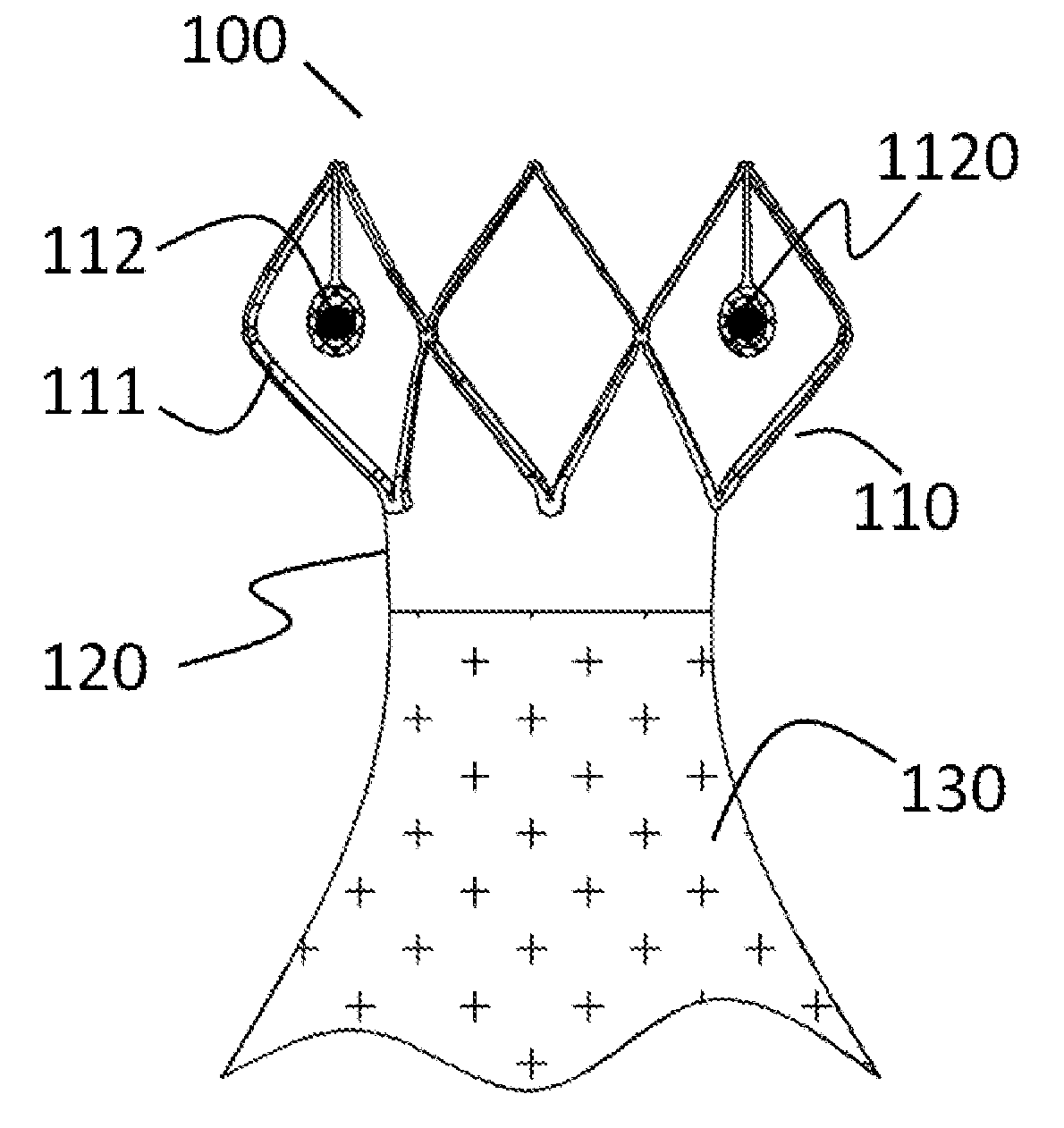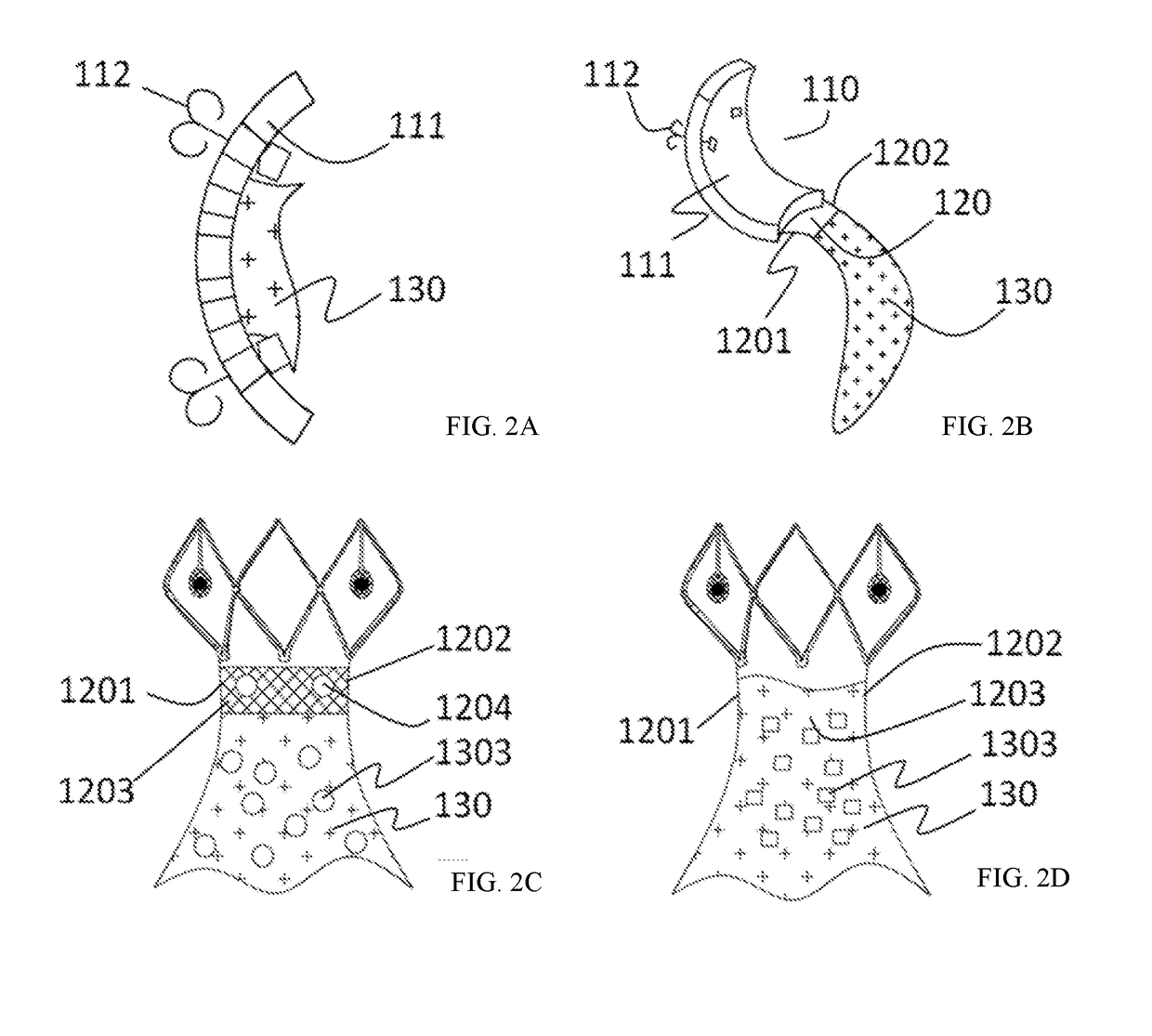Prosthesis for preventing valve regurgitation
a valve and prosthesis technology, applied in the field of medical devices, can solve the problems of increased risk of infection, increased complications and complications, and reduced cardiac pumping and oxygen transfer function, so as to avoid affection to the atrium, prevent adhesion, and reduce the support force
- Summary
- Abstract
- Description
- Claims
- Application Information
AI Technical Summary
Benefits of technology
Problems solved by technology
Method used
Image
Examples
example 1
[0068]Referring to FIG. 1A and FIG. 1B, a prosthesis 100 for preventing valve regurgitation comprises a fixation unit 110, a connection piece 120, and a closure assisting piece 130. The fixation unit 110 comprises a fixation piece 111 and at least two anchors 112. A distal section of the connection piece 120 is connected to a proximal section of the fixation piece 110. A proximal section of the connection piece 120 is connected to a distal section of the closure assisting piece 130. The connection piece 120 is flexible so that the connection piece 120 and the closure assisting piece 130 connected thereto can move along with the movement of the valve leaflets. There is a channel for blood flowing therethrough between the closure assisting piece 130 and the fixation piece 111. The fixation piece 111 is a polymer sheet, or the fixation piece 111 has a frame structure. The fixation piece 111 is fixed to an atrial wall or a valve annulus of a patient by the anchors 112. A width of the de...
example 2
[0071]Referring to FIG. 4A and FIG. 4B, a prosthesis 200 for preventing valve regurgitation comprises a fixation unit 210, a connection piece 220, and a closure assisting piece 230. The fixation unit 210 comprises a fixation piece 211 and at least two anchors 212. A distal section of the connection piece 220 is connected to a proximal section of the fixation member 210. A proximal section of the connection piece 220 is connected to a distal section of the closure assisting piece 230. The connection piece 220 is flexible so that the connection piece 220 and the closure assisting piece 230 connected thereto can move along with the movement of the valve leaflets. There is a channel for blood flowing therethrough between the closure assisting piece 230 and the fixation piece 211. The fixation piece 211 is a polymer mesh or the fixation piece 211 has a frame structure. The fixation piece 211 is fixed to the patient's atrial wall or the valve annulus by the anchor 212. The deployed width ...
example 3
[0075]Referring to FIG. 8A and FIG. 8B, a prosthesis 300 for preventing valve regurgitation comprises a fixation unit 310, a connection piece 320, and a closure assisting piece 330. The fixation unit 310 comprises a fixation piece 311 and at least two anchors 312. A distal section of the connection piece 320 is connected to a proximal section of the fixation unit 310. A proximal section of the connection piece 320 is connected to a distal section of the closure assisting piece 330. The connection piece 320 is flexible so that the connection piece 320 and the closure assisting piece 330 connected thereto can move with the movement of the valve leaflets. There is a blood flowing channel between the closure assisting piece 330 and the fixation piece 311. The fixation piece 311 is a polymer sheet, or the fixation piece 311 has a frame structure. The fixation piece 311 is fixed to the atrial wall or the valve annulus of the patient by the anchor 312. The deployed width of the fixation pi...
PUM
 Login to View More
Login to View More Abstract
Description
Claims
Application Information
 Login to View More
Login to View More - R&D
- Intellectual Property
- Life Sciences
- Materials
- Tech Scout
- Unparalleled Data Quality
- Higher Quality Content
- 60% Fewer Hallucinations
Browse by: Latest US Patents, China's latest patents, Technical Efficacy Thesaurus, Application Domain, Technology Topic, Popular Technical Reports.
© 2025 PatSnap. All rights reserved.Legal|Privacy policy|Modern Slavery Act Transparency Statement|Sitemap|About US| Contact US: help@patsnap.com



